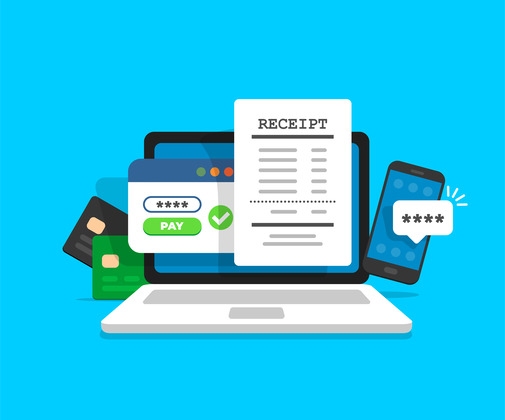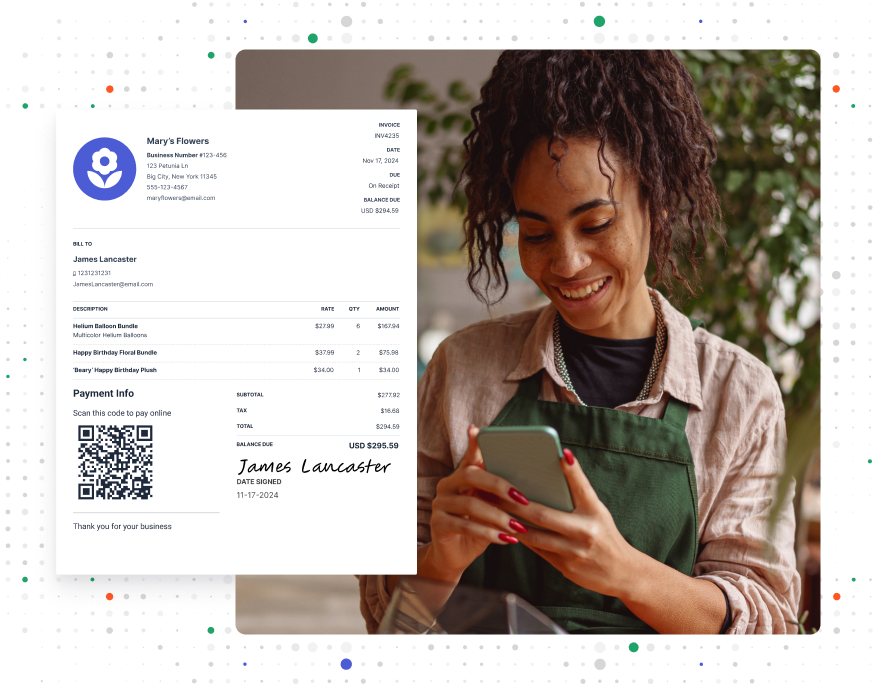How to Write a Receipt of Payment: Best Practices

If you run a business, you know that tracking payments is key to staying organized. That’s why you need to issue receipts.
When a client pays you for a job, it’s a best practice to create a record of it, also known as a receipt of payment. A receipt is a simple document showing that you received their money, whether they made a partial or full payment.
Knowing how to write a receipt of payment helps you keep crystal-clear records. Having this record protects you and your client from any future payment questions. In this article, we’ll give you the rundown on payment receipts and why issuing them should be common practice for your business.
What Is a Payment Receipt?
A payment receipt is a document that a business provides to confirm that it has received money from a customer. This receipt is the proof that a payment was made for a product or service. It’s like a transaction record that you might receive as a paper slip at a store or digitally via email or a mobile app when shopping online.
Issuing a payment receipt is a common way businesses build trust with their customers and keep clear financial records. It’s needed for accounting purposes or in case any questions arise about the payment.
RELATED ARTICLE — Invoice Versus Receipt Basics: Everything Business Owners Need to Know
Receipt of Payment versus Invoice: The Differences

A receipt of payment and an invoice are both important, but they’re not the same.
An invoice is a formal payment request. It’s given to customers before they pay and explains what they owe for products or services. The invoice lists the items or services provided, their quantities, prices, and the amount owed by the customer.
A receipt of payment gets issued after payment is received. That might be after you’ve sent an invoice and the customer mails you a check. While they aren’t always legally needed, issuing a payment receipt is best practice in business operations. It helps build trust and provides clear records for both the business and the customer.
In short: The invoice starts off the sales process by telling you what you owe, and the payment receipt ends the sale by showing proof that the payment was made.
RELATED ARTICLE — How to Write a Past Due Invoice Email
Why Is It Essential to Make a Proof of Payment Receipt?
Creating a proof of payment receipt is an important practice in any business transaction. Here are five reasons why making payment receipts is important for your business:
- Legal Evidence. Receipts are legal proof that a transaction occurred and payment was received. It becomes especially important in disputes or audits. If you don’t have a record in one of these situations, you might face consequences.
- Financial Records. Keeping a detailed record of all receipts helps businesses keep track of their cash flow.
- Tax Purposes. Receipts are essential for tax filings, as they document revenues and expenses. This helps businesses claim appropriate deductions and manage tax liabilities.
- Customer Trust. Giving customers a receipt of payment helps them to know their payment was made correctly. This helps them feel confident with your business practices.
- Clear Transactions. Receipts made the entire transaction clear, so no one is unsure about any of the details. Most receipts include the date, the amount paid, and the payment type.
Business Receipts of Payment
For businesses, issuing payment receipts is a key part of the transaction process. These receipts:
- Provide a reliable record for sales and income.
- Are essential for managing account balances and preparing for financial audits.
- Help in resolving any issues with customer payments.
Customer Receipt of Payment
A receipt of payment is also essential on the customer’s side. For customers receiving a payment receipt:
- The receipt confirms that their payment has been received and processed.
- It acts as proof of a sale, which is necessary for product warranties or returns.
- Tracking expenses helps customers budget and manage their finances. Then, there’s never any question about what they were charged for.
RELATED ARTICLE — How to Write a Strong Invoice Email – 3 Examples/Templates
Is It Mandatory to Write a Receipt of Payment?
The short answer is no. But, whether you legally need to provide a payment receipt can depend on the country you work in. And no matter your location, issuing a receipt of payment is always a good business practice.
Because receipts help businesses with record-keeping, they’re often consulted during financial audits. For example, in the US, the IRS may request these records if your business is audited. The IRS will want to see all financial statements to make sure they’re correct. Receipts would be an important part of those records.
RELATED ARTICLE — How to Write an Invoice for Freelance Work
How to Write a Receipt of Payment: What to Include
As a business owner, you’ll want to make a clear and well-crafted receipt of payment for your customers. Here’s a guide on what should be included on a receipt of payment:
- Heading. Label the document as a “Payment Receipt” to immediately identify its purpose.
- Receipt Number. Include a different number for each receipt to help track transactions. Try to use a numbering system that matches your invoice numbers. This helps you know which receipt is for which invoice.
- Business Name and Details. List the full name of the business, along with its physical address and contact information.
- Customer Information. Put the customer’s name and contact details on the business receipt. This helps personalize the receipt and show who made the payment.
- Payment Date. Record the exact date when the payment was received for an accurate timeline of financial transactions.
- Amount Paid and Amount Due. Specify the amount of money received and, if applicable, any remaining balance the customer still owes.
- Additions and Deductions. If any extra charges apply or if any deductions were made, they should be listed.
- Payment Method. Show how the payment was made (e.g., cash, credit card, bank transfer) to provide a clear record of the transaction method.
- Item Description (Optional). Include a brief description of the service or product paid for. This is especially important if the payment is partial or covers many items.
- Tax Information (Optional). Include details of any taxes added to the cost to help with tax reporting.
- Signature Line. Include a space for the signature of the person issuing the receipt.
RELATED ARTICLE — How to State Invoice Payment Terms (with Example Wording)
4 Pro Tips to Make a Receipt of Payment

Creating a receipt of payment can be intimidating. There are many things to include so it’s professional and represents your business brand in a positive light. Here are a few strategies to help you create valuable and clear business receipts:
- Customize Your Receipt Template. Tailor a receipt template to reflect your brand, including your logo and business color scheme. Customization keeps your receipts looking professional and promotes your business with every transaction.
- Send Receipts Right Away. Always send the payment receipt as soon as you process the payment. Doing this shows your customer that you’re responsive by confirming the transaction. Plus, if any disagreements or issues arise, you can then address them right away.
- Maintain Both Digital and Physical Copies. To be extra reliable, provide receipts in both digital and physical forms. An online version is very convenient, while a handwritten or printed receipt can be physical proof of payment.
- Free Receipt Templates. To help you get started, make a receipt using free, professional templates. Take a look at these free receipt templates from Invoice Simple. You can customize them for different transactions. This can go a long way in saving you time and keeping receipts consistent.
RELATED ARTICLE — Itemized Invoices: Definition and Uses
Send Professional Receipts and Invoices with Invoice Simple
With Invoice Simple, you can send invoices, receive payments, and issue a receipt from one platform. We’ll even safely store your customer’s details from the original invoice or quote to create your receipt in seconds.
You can log in to your account from anywhere to make updates or check your invoicing records. Make your payment process easier today with Invoice Simple.
Start Your First
Invoice Today
Create customized and professional
invoices and connect with clients
